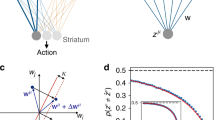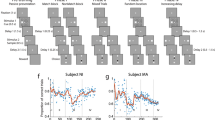Abstract
When learned in quick succession, declarative and motor skill tasks interfere with one another and subsequent recall is impaired. Depending on the order of the tasks, we were able to prevent memory interference in humans by applying transcranial magnetic stimulation to either the dorsolateral prefrontal or the primary motor cortex, and neither memory was impaired. Our observations suggest that distinct mechanisms support the communication between different types of memory processing.
This is a preview of subscription content, access via your institution
Access options
Subscribe to this journal
Receive 12 print issues and online access
$209.00 per year
only $17.42 per issue
Buy this article
- Purchase on Springer Link
- Instant access to full article PDF
Prices may be subject to local taxes which are calculated during checkout


Similar content being viewed by others
References
Brashers-Krug, T., Shadmehr, R. & Bizzi, E. Nature 382, 252–255 (1996).
Lechner, H.A., Squire, L. & Byrne, J. Learn. Mem. 6, 77–87 (1999).
Walker, M.P., Brakefield, T., Hobson, J.A. & Stickgold, R. Nature 425, 616–620 (2003).
Brown, R.M. & Robertson, E.M. J. Neurosci. 27, 10468–10475 (2007).
Keisler, A. & Shadmehr, R. J. Neurosci. 30, 14817–14823 (2010).
Brashers-Krug, T., Shadmehr, R. & Todorov, E. in Advances in Neural Information Processing Systems Vol. 7 (eds. Tesauro, G., Touretzky, D.S. and Leen, T.K.) 19–26 (MIT Press, Cambridge, Massachusetts, 1995).
Robertson, E.M. PLoS Biol. 7, e19 (2009).
Silvanto, J., Muggleton, N. & Walsh, V. Trends Cogn. Sci. 12, 447–454 (2008).
Silvanto, J. & Pascual-Leone, A. Brain Topogr. 21, 1–10 (2008).
Robertson, E.M. J. Neurosci. 27, 10073–10075 (2007).
Robertson, E.M., Pascual-Leone, A. & Press, D.Z. Curr. Biol. 14, 208–212 (2004).
Robertson, E.M., Press, D.Z. & Pascual-Leone, A. J. Neurosci. 25, 6372–6378 (2005).
Spencer, R.M., Sunm, M. & Ivry, R.B. Curr. Biol. 16, 1001–1005 (2006).
Diekelmann, S. & Born, J. Nat. Rev. Neurosci. 11, 114–126 (2010).
Acknowledgements
We are grateful to R. Brown, L. Iguichi, N. Mosha and S. Tunovic for their assistance with the experiments, and to A. Galaburda, A. Pascual-Leone and R. Stickgold for their encouraging and constructive comments. This work was supported by the US National Institutes of Health (R01 NS051446 and NS051446-03S1, E.M.R.) and the National Science Foundation (Division of Behavioral and Cognitive Sciences 0921177, E.M.R.). Our work also benefited from the infrastructure supplied by the Harvard Clinical and Translational Science Center (from the National Center for Research Resources, UL1 RR025758 and M01 RR01032).
Author information
Authors and Affiliations
Contributions
D.A.C. conducted the experiments and helped write the manuscript. E.M.R. designed the study, conducted the experiments, analyzed the data and wrote the manuscript.
Corresponding author
Ethics declarations
Competing interests
The authors declare no competing financial interests.
Supplementary information
Supplementary Text and Figures
Supplementary Figures 1–4, Supplementary Introduction, Supplementary Results, Supplementary Discussion and Supplementary Methods (PDF 435 kb)
Rights and permissions
About this article
Cite this article
Cohen, D., Robertson, E. Preventing interference between different memory tasks. Nat Neurosci 14, 953–955 (2011). https://doi.org/10.1038/nn.2840
Received:
Accepted:
Published:
Issue Date:
DOI: https://doi.org/10.1038/nn.2840
This article is cited by
-
Bidirectional competitive interactions between motor memory and declarative memory during interleaved learning
Scientific Reports (2020)
-
A Novel Approach to Sensorimotor Skill Acquisition Utilizing Sensory Substitution: A Driving Simulation Study
Scientific Reports (2019)
-
Dual enhancement mechanisms for overnight motor memory consolidation
Nature Human Behaviour (2017)
-
Reward disrupts reactivated human skill memory
Scientific Reports (2016)
-
Interference effects between memory systems in the acquisition of a skill
Experimental Brain Research (2016)



